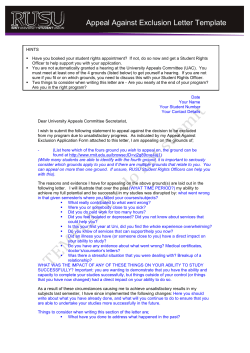
Basic Concepts Adaptive Random Testing
Basic Concepts • Input domain – set of all possible inputs • Failure-causing inputs – inputs that exhibit failures • Exhaustive testing – Adaptive Random Testing T. Y. Chen – to test the program with the entire input domain – it is practically infeasible tychen@swin.edu.au Centre for Software Analysis and Testing Swinburne University of Technology Melbourne, Australia 1 2 Random Testing failure-causing inputs • Random Testing – selects test cases from the entire input domain randomly and independently • Advantages: – Intuitively simple – Allows statistical quantitative estimation of the software’s reliability 3 4 How to improve random testing How to improve random testing • Any common information or characteristics to all faulty programs? • Any common information or characteristics to all faulty programs? Failure-causing inputs 5 6 Patterns of failure-causing inputs Types of Failure Patterns Strip Pattern • Strip Pattern • Block Pattern • Point Pattern Block Pattern Pattern Point 7 Strip Pattern Two Dimensional Input Domain 8 Block Pattern Two Dimensional Input Domain If (2*x – y > 10) /* the correct statement is If (2*x – y > 20) */ z = x/2 *y; else z := x*y; If (x >= 4 and x <=6) and (y >= 4 and y <= 6) z := x + y; /* the correct statement is z := x - y; */ else z := 100; 9 Point Pattern Two Dimensional input domain 10 Which pattern occurs more frequently? If ((x mod 10) = 0) and ((y mod 10) = 0) and ( x > 2) then z:= f(x, y); /* should be z:= g(x,y); */ else z := f(x, y); block and strip patterns 11 12 Intuition of ART Intuition for ART Failure-causing pattern fixed but unknown r r o o t 13 14 Intuition of ART Adaptive Random Testing for non-point failure patterns – an even spread of random test cases will enhance the fault detection capabilities r o r t 15 Adaptive Random Testing 16 How to achieve “even spread”? Simulation and empirical results showed that as compared with random testing, fewer test cases needed to detect the first failure (smaller F-measure) F-measure of ART ≅ 50-60% of that of RT 17 1) 2) 3) 4) 5) notion of distance notion of exclusion notion of partitioning notion of perturbation … 18 ART by distance ART by distance T1 T1 C1 C3 C2 19 ART by distance 20 ART by exclusion T1 T1 T2 21 ART by exclusion 22 ART by exclusion C1 C1 T1 T1 C2 C3 23 24 ART by exclusion ART by exclusion T1 T1 T2 T2 25 ART by partitioning 26 ART by partitioning Region 1 T1 Region 2 T1 Region 3 Region 4 27 ART by partitioning Region 1 28 ART by partitioning Region 2 Region 1 T1 Region 2 T1 Region 4.1 T2 Region 4.2 T2 Region 3 Region 3 Region 4.3 29 Region 4.4 30 Various Even Spread Approaches Categories of Failure Patterns Different advantages and disadvantage Different applications Different research interests • Classification of failure patterns into block, strip and point is too coarse • • • – – Distance - distance measures, size of candidate set, .. Exclusion –exclusion amount, shape of exclusion region 31 32 Number of Failure Patterns ART F-ratio = F A R T / F R T = 1.1 +… + + 1 0.9 0.8 0.7 0.6 0 10 20 30 40 50 60 70 80 90 100 Number of equally sized 2D square failure regions failure rate = 0.005 failure rate = 0.001 failure rate = 0.0005 33 34 Compactness of Failure Pattern ART F-ratio = F A R T / F R T 1.00 a r 1 = a 0.95 0.90 0.85 0.80 0.75 0.70 0.65 0.60 0 10 20 30 40 50 60 70 80 90 100 r 0.005 35 0.001 0.0005 36 Distributions of Size of Failure Patterns + ART F-ratio = F ART / FRT = 1.1 + … + 1 0.9 0.8 0.7 0.6 0 10 20 30 40 50 60 70 80 90 100 Number of failure regions equal uniform 50% dominant 80% dominant 37 Categories of Failure Patterns 38 Theoretical Analysis • Number of failure patterns • Compactness of failure patterns • Distributions of sizes of failure patterns • Theoretical analysis is very difficult 39 Theoretical Analysis 40 Example • Assumptions: – size, shape and orientation of failure patterns are known (but not their locations) • Theoretically proved – The best possible test case selection scheme has an expected F-measure equal to half that of random testing 41 42 Partition Testing versus Random Testing Partition Testing and Random Testing Suppose the domain is divided into two partitions of different sizes. Assume one test case is selected from each partition for the case of partition testing, and two test cases are selected for the case of random testing. • Sufficient conditions for partition testing to perform better than random testing – P-measure: probability of detecting at least one failure – E-measure: expected number of failures detected Which method is more effective? 43 44 Conclusion Proportional Sampling Strategy • Use ART instead of RT • All partitions have the same sampling rates • Random selection of test cases 45 46
© Copyright 2025





















